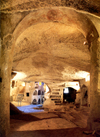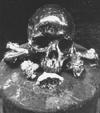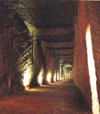|
|
 The
San Gennaro Catacombs The
San Gennaro Catacombs
There are numerous places and images of San Gennaro, the fervently loved
patron Saint of the city, which one encounters here and there in Naples
and the surrounding areas. These are signs of a devotion still very much
alive and felt among the lower classes. Among the sacred places dedicated
to the Saint, aside from the Cathedral
(Duomo), particularly suggestive are the catacombs located off the road
that leads to Capodimonte, near the monumental Church of Madre del Buon
Consiglio. In these catacombs, to bear witness to how old the devotion to
the Martyr is, the visitor may admire the oldest portrait of the saint,
dating back to the 5th century A.D. Wandering among the niches that hold
urns and the arcosoli [a tomb for one or more persons cut into the tuff
and covered with an arch, also carved into the stone], one is easily fascinated
by the splendid pictorial cycles decorating the walls. Simple and suggestive,
these cycles are among the most important examples of Southern Italian Paleochristian
figurative art. The monument's original nucleus goes back to as early as
the end of the 2nd century A.D. It had been a patrician family's ancient
tomb and was later donated to the Christian Community that turned it into
both an official cemetery and a meeting point for the Christian Community
of the time. In the 3rd century A.D., it hosted (buried and venerated) Saint
Agrippino, the first patron saint of the city. When San Gennaro's remains
arrived, two centuries later, the space was enlarged and made more suitable
to welcome the steadily growing devotion: visits and processions became
more frequent as the saint's works and miracles increased. The catacombs
are open every day from 9:00 am to 1:00 pm. For information, phone: 0817411071
|
 The
San Gaudioso Catacombs. The
San Gaudioso Catacombs.
Like those of San Gennaro, these catacombs also preserve wall fresco cycles
of noteworthy workmanship which are amongst the most relevant of the late-ancient
and high medieval world. The origin of these frescos is tied to this Saint
who, after having been the Bishop of Bitinia and persecuted by King Genseric,
arrived by chance in Naples where he lived and passed away. The San Gaudioso
Catacombs are accessible from the seventeenth-century Santa
Maria alla Sanità (there is a passageway behind the main altar) below
which church, the catacombs unfold to a journey not only to the most ancient
examples of Christian iconography but, as well, to a discovery of the rites
and typical customs. The sight of the benches (the so-called "cantarelle",
dug in the tuff rock and having a central hole corresponding to the seat)
is unique and touching; the benches were meant to host the deceased until
all bodily humors were released and gathered in receptacles underneath;
only at such time would the defunct then be allowed to be buried. It is
an ancient practice, the traces of which can still be heard in the vukgar
Neapolitan expression, "puozza sculà" (may you drain away), addressed, as
a death wish, to one's own enemies. Guided visits during morning and afternoon
hours by appointment. Call: 081483238 |
 The
Fontanelle Cemetery. The
Fontanelle Cemetery.
Macabre and suggestive, it is the most well known of the city's historical
hypogea, a unique and irreproducible place that shows the peculiar and yet
very tight relationship between Neapolitans and death. An absolutely original
place for devotees and the curious, who gasp at the high piles of skulls,
thighbones, shoulders and shinbones that fill the caves. Here, the sacred
and profane, magic and religion, all blend together in the name of the souls
of Purgatory, known as pezzentelle (little begging souls) who, in need of
intercession, find relief solely in the peculiar nature of a popular custom:
the cult of human bones, belonging to the nameless dead and left to the
prayers of the people, prayers which will speed the passage from Purgatory
to Paradise. What is the rite? It consists of adopting skulls, to which
are offered psalms and prayers as well as flowers and candles; above all,
they are given a careful cleaning and polishing. These caves were used,
for the first time, as a burial ground in 1656 in order to face the burial
emergency caused by the plague, which, at a pace of 1,500 deaths daily,
decimated the population by saturating holy grounds of churches and small
ossuaries. Graves were even being dug in streets and squares! When the epidemic
ended, these caves that were overflowing with piled up, unburied bodies
were sealed with lime. So, for centuries this cemetery was reopened only
to take either the victims of other plagues or the remains of those evicted
from the municipal graves as was the case when the Napoleonic laws ordered
such removal. Curious note: the number of devotees, who on Mondays took
care of these nameless skulls as if they were relatives, was so high that
up to the 1950's, a streetcar line served the area for this specific purpose.
|
 Purgatorio
ad Arco Purgatorio
ad Arco
The same cult, with rites similar to those practiced in the Fontanelle Cemetery,
also exists at the hypogeum of Santa
Maria delle Anime del Purgatorio ad Arco, the church located on Via
dei Tribunali, just in front of the characteristic medieval
porticos of the old d'Avalos palace. This church is recognizable right
away from its four small piperno stone columns, crowned with bronze skulls
and thighbones. Smoothed down and shiny from the touch and caresses left
by passersby as a sign of devotion, these are at the entrance to the church
and have conferred upon the church a better-known, more popular name: the
church of the cap''e muorto [skulls]. Once inside, a small stairway, somewhat
hard to spot, leads to the smaller church below where, toward the end of
the 1600s, an ignorant and superstitious populace met with the aristocracy.
Both sought indulgences and divine protection, and both were joined by the
desire to pray. As many as sixty masses a day were celebrated for the souls
of Purgatory in exchange for graces and small favors. High, painted vaults
and a few decorative elements scattered here and there fill the crypt, annexed
to the suggestive cemetery area that, beyond the long tombstone-covered
hallway, leads into the larger and more touching room meant for underground
burials of people of low rank who had been followers of the congregation.
The rituals continued non-stop until 1980 in spite of the fact that the
cult of the dead not only found no support from religious authorities, but
met with steadfast opposition. That year marked the start of a long period
of closure of the church, a period that lasted until 1992 and which ended
thanks to the intervention of the cultural association named Incontri
Napoletani. The niches with the human bones recovered from the scared
ground of the common graves were, in fact, a place of pilgrimage for devotees
who wanted, through prayers, flowers, candles and small holy pictures, to
bring solace to those poor nameless souls, all in exchange for small, little
favors performed in the hereafter, favors which, in return, were repaid
in this world ex-voto in gold, silver, papier-mâché and terracotta. |
 Greco-Roman
ruins. Greco-Roman
ruins.
Greek walls. In the great open-sky museum that Naples offers to us
at various places around the city, parts of Greek walls rise on the surface
at Piazza Bellini. They intersect between Port'Alba and San Pietro a Majella,
where large tuff stone blocks, finely shaped and chained together, offer
passersby a picturesque sampling of the double-row walls of Neapolis, the
Greek city founded in the 6th century B.C. according to the typical three-axes
orthogonal grid (East-West direction) and intersected by a thick series
of smaller streets (North-South direction). |
 San
Lorenzo excavation site. San
Lorenzo excavation site.
The Greco-Roman presence that archeologists have brought to light is, in
small part, more widely and better stratified beneath the Franciscan Basilica
of Saint Lorenzo Maggiore on Via dei Tribunali. Here one strolls right in
the heart of Neapolis, its ancient agora or the main square of the ancient
Greek city, which became the forum for the Romans. It is accessed from the
18th-century cloister. Passing from present to past lasts just the few seconds
it takes to go down a small stairway. There is one intermmediate stop where
you can see the medieval ruins of the ducal city, part of the San Lorenzo
Seggio where, in the 6th century A.D, reunions were held of the people's
representatives elected to administer justice. The last flight of stairs,
however, takes you back about 2,500 years to the 600 B.C., that is to say,
to a Roman street of the same piperno stone that quite resembles modern
paving stones of the city streets of today. By following the tracks of wagon
carts, you run along the row of shops: from the baker's, with its hatchway
and dome oven, to the laundry shop (fullonica) with channels for water drainage
and tubs for dying clothes. Just ahead, you find the aerarium, where the
city's treasury was kept, as can be seen by the holes that held iron bars
at the windows and the reinforced architrave of the doorway; then, there
is the cistern for water collection; and finally, almost intact, is the
cryptoporticus, the large covered Roman market with a series of sales-counters
in stone that include a good number of storage niches. This is the center
of the Greek polis; all around, corresponding to San Gaetano Square above,
were all the main city buildings of Neapolis; the two theaters: the larger
open air theater and the covered concert hall, the Dioscuri Temple, now
transformed into the Saint Paolo Maggiore Basilica; the macellum, that is
to say the food market with shops along the perimeter of the rectangular
portico; and, in the center of the open air mosaic paved area, the tholos,
a small circular temple adorned with polychrome marbles. |

The
Seiano Grotto.
This magnificent tunnel of the Roman Era (1st century B.C.) is located
a few steps from tiny Nisida island, between Bagnoli and Posillipo, and
it connects the Coroglio slope to the fishermen's village at Gaiola. Entirely
dug in the tuff rock, and known as "Seiano" after one of emperor Tiberius'
ministers who probably had it built, the Grotto cuts across the tip of
the Posillipo Peninsula for about 800 meters, combining the thrill of
an underground journey to the beauty of a unique panorama of Trentaremi
beach from within the bowels of the earth. Precisely that! -a view from
within the cliff, itself, that falls sheer to the sea. Disturbing and
breathtaking, this view can be had from within the large lateral shaft-openings
along the length of the grotto: three underground passages on the southern
side created by architect Lucius Cocceius to guarantee light and ventilation
to the long, dark pathway, tunneled out to provide easier access to Pollio's
villa, only reachable by sea otherwise. The republican knight Publius
Vedius Pollio then left his monumental Pausilypon residence as inheritance
to emperor Octavian Augustus. The Seaiano Grotto, evidence of the advanced
design, technical and building abilities of Roman engineering, was forgotten
for centuries. It was only rediscovered by chance in 1840, during the
construction of the Coroglio Ramp, built at the behest of Ferdinand II
of Bourbon who, fascinated by the discovery, ordered its restoration.
|
| Photos:
courtesy of Monica Biancardi, Archeological complex of |
| San Lorenzo Maggiore,
Libero De Cunzo, , Laes Association, | | Lucia
Pagano, Renato Quaranta, Sagep. |
|
|
